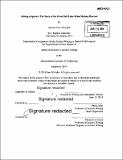Seizing a species : the story of the Great Salt Lake brine shrimp harvest
Author(s)
Wotipka, Samuel Alex
DownloadFull printable version (3.323Mb)
Alternative title
Story of the Great Salt Lake brine shrimp harvest
Other Contributors
Massachusetts Institute of Technology. Graduate Program in Science Writing.
Advisor
Philip Hilts.
Terms of use
Metadata
Show full item recordAbstract
In the early 1950s, C.C. "Sparkplug" Sanders began harvesting brine shrimp from Utah's Great Salt Lake. Sanders built up a small business selling their eggs, called "cysts, to aquarium stores across the country. During the 80s, cysts were found to be an effective food source for aquaculture and a multimillion-dollar commercial harvesting industry quickly emerged. As the cysts rose in value, competition between harvesters grew fierce and annual catches soon began to drop. Environmentalists also became concerned, as the shrimp are an important food source for millions of migratory birds. The harvest was almost entirely unregulated during this period. Unlike other fisheries, where industry members have fought government intervention, many of the harvesters called on the state to increase oversight. Scientists hired by Utah's natural resource agency found that no comprehensive studies had ever been conducted on the lake's ecosystem, complicating initial efforts to manage the harvest. A twenty-year effort by the state, harvesters and other stakeholders to develop a science-based management strategy has recently begun to pay off as cyst populations appear to be stabilizing and the harvesting industry has once again become profitable.
Description
Thesis: S.M. in Science Writing, Massachusetts Institute of Technology, Department of Humanities, Graduate Program in Science Writing, 2014. Cataloged from PDF version of thesis. Includes bibliographical references (pages 24-26).
Date issued
2014Department
Massachusetts Institute of Technology. Graduate Program in Science Writing; MIT Program in Writing & Humanistic StudiesPublisher
Massachusetts Institute of Technology
Keywords
Graduate Program in Science Writing.